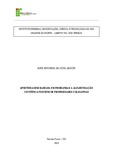Aprendizagem baseada em problemas: a alfabetização científica no ensino de propriedades coligativas

Visualizar/
Data
2023-06-27Autor
Araújo, Jáfia Eduarda da Silva
http://lattes.cnpq.br/1689384595481276
Metadado
Mostrar registro completoResumo
Several factors contribute to the understanding of the world by individuals, one of them is
directly linked to science education, its reading from scientific knowledge. For this reason, a
relentless pursuit of science education is the promotion of scientific literacy (SCI), which is
divided into three basic axes according to Sasseron and Carvalho (2011) - Basic
understanding of scientific terms, knowledge and concepts, understanding of the nature of
science and ethical and political factors and understanding of the relationships between
science, technology, society and the environment. In this path, aiming to identify how the
active methodology of Problem-Based Learning (PBA) contributes to the development of
Scientific Literacy in high school students, using the theme of colligative properties, a
pedagogical intervention was developed with the theme: "Problem-based learning: Scientific
Literacy in the teaching of colligative properties". The activity was applied in a 4th class of
the Integrated Technical Teaching in Informatics of the Federal Institute of Education,
Science and Technology of Rio Grande do Norte (IFRN), Campus Pau dos Ferros, during the
activities of the Institutional Program of Scholarships for Teacher Initiation (PIBID) and had
as a general objective to identify how the active methodology of ABP contributes to the
development of CA of integrated high school students using the content of colligative
properties . The podcasts recorded by the students were transcribed and analyzed using
Textual Discourse Analysis (TDA), which allows a greater understanding and ownership of
the analyzed data, which seeks to interpret these data in a hermeneutic perspective. The
recording addressed the experiments performed and their relations with the colligative
properties, so in the analysis by means of the DTA these relations were sought. Thus, the
analyses made it possible to verify that, when working with the active ABP methodology, it is
possible to realize a significant understanding of the chemical concepts studied, through the
relationships woven between concepts, experiments, and everyday life. These results show
that it was possible to perceive the development of CA and its three main axes.



